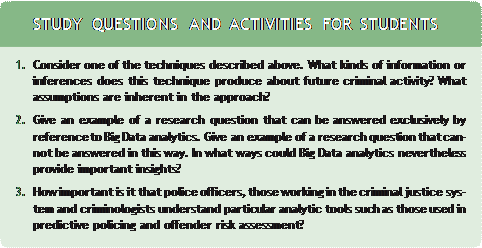 |
Summary and review
|
|
|
|
There are many potential applications for Big Data analytics in criminology research. This chapter has focused on two predictive techniques used in law enforcement and criminal justice – predictive policing and offender risk assess- ment. Big Data techniques allow researchers to gain insights from larger volumes of data than could be analysed without them, possibly discovering pat- terns that might otherwise remain hidden. However, it is important to understand both the limitations of these techniques and their potential, when used as the basis for intervention, to yield unanticipated or undesirable results. They will be more useful in answering some kinds of research questions (exploratory and descriptive research) than others (understanding causal mech- anisms). They should thus be used only with an understanding of their limitations and biases, and their use (particularly where there is an impact on individuals) should be carefully evaluated.
This chapter has detailed in relation to the following:
Defining Big Data:
• The most common definition focuses on data having high volume, high veloc- ity (speed of production and processing) and high variety (of data types and sources), although there is a range of other definitions.
Uses of Big Data in crime prediction:
• Predictive policing is used by police to target particular locations and times, or occasionally individuals, where the likelihood of criminal activity is heightened.
• Offender risk management attempts to quantify risk for the purposes of bail, parole or sentencing decisions. One technique that can be used is the random forest algorithm.
Limitations:
• accuracy and representativeness of data
• challenges in data linking and tracking provenance of data
• based on correlation rather than causation
• inductive bias
• differential impact on subpopulations and the potential for discrimination
• fairness of use, particularly in criminal justice decision making.
Challenges for researchers:
• access to algorithm or analytic technique used
• access to data employed by the algorithm or technique as a basis for future predictions
• evaluation of predictive accuracy distinguished from evaluation of effectiveness.
 | |||
 | |||
 SUGGESTIONS FOR FURTHER READING
SUGGESTIONS FOR FURTHER READING
Various books and articles provide critical commentary on the use of Big Data techniques, either generally or particularly in the context of criminal justice.
While somewhat dated as to particular tools being used, Harcourt, B. E. (2007) Against Prediction: Profiling, Policing and Punishing in an Actuarial Age. Chicago, IL: University of Chicago Press remains an excellent source for a review of concerns around data- driven approaches in this area.
Chan, J. and Bennett Moses, L. (2016) ‘Is Big Data challenging criminology? ’, Theoretical Criminology, 20: 21–39 provides an overview of the use of Big Data in criminology. In the particular context of predictive policing, see Bennett Moses, L. and Chan, J. (2018) ‘Algorithmic prediction in policing: assumptions, evaluation, and accountability’, Policing and Society, 28(7): 806-822. doi: 10. 1080/10439463. 2016. 1253695.
|
|
|
For a student-friendly technical account of some of the techniques used in offender risk assessment, see Berk, R. (2012) Criminal Justice Forecasts of Risk: A Machine Learning Approach. New York: Springer.

 REFERENCES
REFERENCES
Angwin, J., Larson, J., Mattu, S. and Kirchner, L. (2016) ‘Machine bias’, ProPublica, 23 May. Available at: www. propublica. org/article/machine-bias-risk-assessments-in-criminal- sentencing (accessed 2 May 2018).
Arnold Foundation (2013) Developing a National Model for Pre-trial Risk Assessment (November). Available at: www. /wp-content/uploads/2014/02 arnoldfoundation. org/ LJAF-research-summary_PSACourt_4_1. pdf (accessed 10 July 2018).
Beck, C. and McCue, C. (2009) ‘Predictive policing: what can we learn from WalMart and Amazon about fighting crime in a recession? ’, The Police Chief, 76(11): 20–9.
Bennett Moses, L. and Chan, J. (2018) ‘Algorithmic prediction in policing: assumptions, evalua- tion, and accountability’, Policing and Society, 28(7): 806-822. doi: 10. 1080/10439463. 2016. 1253695.
Berk, R. (2012) Criminal Justice Forecasts of Risk: A Machine Learning Approach. New York: Springer.
Berk, R. and Bleich, J. (2013) ‘Statistical procedures for forecasting criminal behavior’,
Criminology & Public Policy, 12(3): 513–44.
Bowers, K. J., Johnson, S. D. and Pease, K. (2004) ‘Prospective hot-spotting: the future of crime mapping? ’, British Journal of Criminology, 44(5): 641–58.
boyd, d. and Crawford, K. (2012) ‘Critical questions for Big Data: provocations for a cul- tural, technological, and scholarly phenomenon’, Information, Communication and Society, 15: 662–79.
Chan, J. and Bennett Moses, L. (2016) ‘Is Big Data challenging criminology? ’, Theoretical Criminology, 20: 21–39.
Chan, J. and Bennett Moses, L. (2017) ‘Making sense of Big Data for security’, British Journal of Criminology, 57(2): 299–319.
Gerber M. S. (2014) ‘Predicting crime using Twitter and kernel density estimation’, Decision Support Systems, 61: 115–25.
Harcourt, B. E. (2007) Against Prediction: Profiling, Policing and Punishing in an Actuarial Age. Chicago, IL: University of Chicago Press.

Hart, T. C. and Zandbergen, P. A. (2012) Effects of Data Quality on Predictive Hotspot Mapping: Final Technical Report. Washington, DC: National Institute of Justice, 239861.
Hunt, P., Saunders, J. and Hollywood, J. S. (2014) Evaluation of the Shreveport Predictive Policing Experiment. Santa Monica, CA: RAND.
Johnson, S. D. and Bowers, K. J. (2004) ‘The stability of space–time clusters of burglary’,
British Journal of Criminology, 44(1): 55–65.
Kamiran, F., Calders, T. and Pechenizkiy, M. (2013) ‘Techniques for discrimination-free predictive models’, in B. Custers, T. Calders, B. Schermer, and T. Zarsky (eds), Discrimination and Privacy in the Information Society: Data Mining and Profiling in Large Databases. Heidelberg: Springer, pp. 223–40.
Kitchin, R. (2014) ‘Big Data, new epistemologies and paradigm shifts’, Big Data and Society, 1: 1–12.
|
|
|
Mayer-Schö nberger, V. and Cukier, K. (2013) Big Data: A Revolution That Will Transform How We Live, Work and Think. London: John Murray.
Mitchell, T. M. (1997) Machine Learning. New York: McGraw-Hill.
Mohler, G. O., Short, M. B., Brantingham, P. J., Schoenberg, F. P. and Tita, G. E. (2011) ‘Self- exciting point process modeling of crime’, Journal of the American Statistical Association, 106(493): 100–8.
National Center for State Courts (2007) Conference of Chief Justices and Conference of State Court Administrators, Resolution 12: In Support of Sentencing Practices that Promote Public Safety and Reduce Recidivism (1 August). Available at: http: //ncsc. con tentdm. oclc. org/cdm/ref/collection/ctcomm/id/139 (accessed 2 May 2018).
O’Neil, C. (2016) Weapons of Math Destruction: How Big Data Increases Inequality and Threatens Democracy. New York: Crown.
Pearl, J. (2009) Causality: Models, Reasoning, and Inference, 2nd edition. New York: Cambridge University Press.
Perry, W. L., McInnis, B., Price, C. C., Smith, S. C. and Hollywood, J. S. (2013) Predictive Policing: The Role of Crime Forecasting in Law Enforcement Operations. Santa Monica, CA: RAND.
Procter, R., Vis, F. and Voss, A. (2013) ‘Reading the riots on Twitter: methodological innova- tion for the analysis of Big Data’, International Journal of Social Research Methodology, 16(3): 197–214.
Schauer, F. (2003) Profiles, Probabilities and Stereotypes. Cambridge, MA: Harvard University Press.
State v Loomis (2016) 881 N. W. 2d 749 (Wis. 2016).
Traunmueller, M., Quattrone, G. and Capra, L. (2014) ‘Mining mobile phone data to inves- tigate urban crime theories at scale’, in L. M. Aiello and D. McFarland (eds), Social Informatics: Lecture Notes in Computer Science. Dordrecht: Springer, pp. 396–411.
Uchida, C. (2014) ‘Predictive policing’, in G. Bruinsma and D. Weisburd (eds), Encyclopedia of Criminology and Criminal Justice. New York: Springer, pp. 3871–80.
 Verwer, S. and Calders, T. (2013) ‘Introducing positive discrimination in predictive models’, in B. Custers, T. Calders, B. Schermer and T. Zarsky (eds), Discrimination and Privacy in the Information Society: Data Mining and Profiling in Large Databases. Heidelberg: Springer, pp. 255–72.
Verwer, S. and Calders, T. (2013) ‘Introducing positive discrimination in predictive models’, in B. Custers, T. Calders, B. Schermer and T. Zarsky (eds), Discrimination and Privacy in the Information Society: Data Mining and Profiling in Large Databases. Heidelberg: Springer, pp. 255–72.
Watters, P. A. and Phair, N. (2012) ‘Detecting illicit drugs on social media using Automated Social Media Intelligence Analysis’, in Y. Xiang, J. Lopez, C. -C. J. Kuo, et al. (eds), Cyberspace Safety and Security Lecture Notes in Computer Science. Heidelberg: Springer, pp. 66–76.
Williams, M. L. and Burnap, P. (2016) ‘Cyberhate on social media in the aftermath of Woolwich: a case study in computational criminology and Big Data’, British Journal of Criminology, 56: 211–38.
Williams, M. L., Burnap, P. and Sloan, L. (2017) ‘Crime sensing with Big Data: the affor- dances and limitations of using open-source communications to estimate crime patterns’, British Journal of Criminology, 57(2): 320–40.
Williams, M. L., Edwards, A., Housely, W., et al. (2013) ‘Policing cyber-neighbourhoods: tension monitoring and social media networks’. Policing and Society, 23(4): 461–81.
|
|
|


